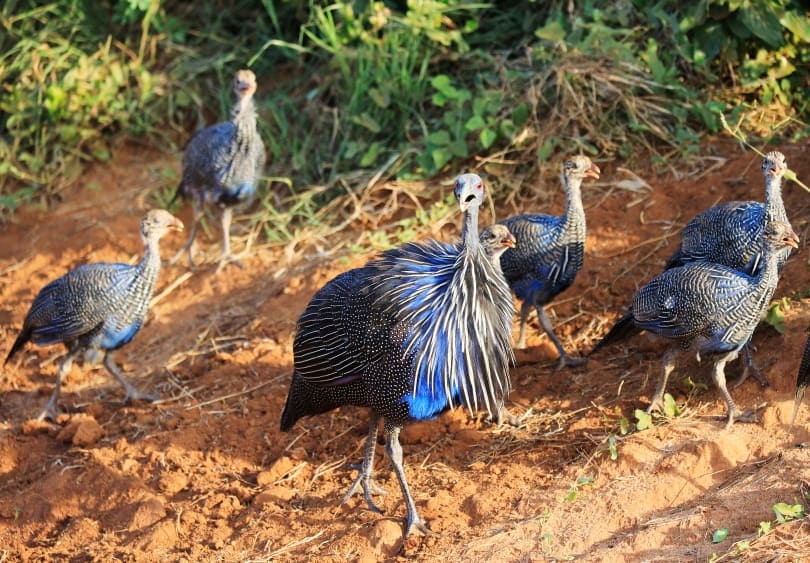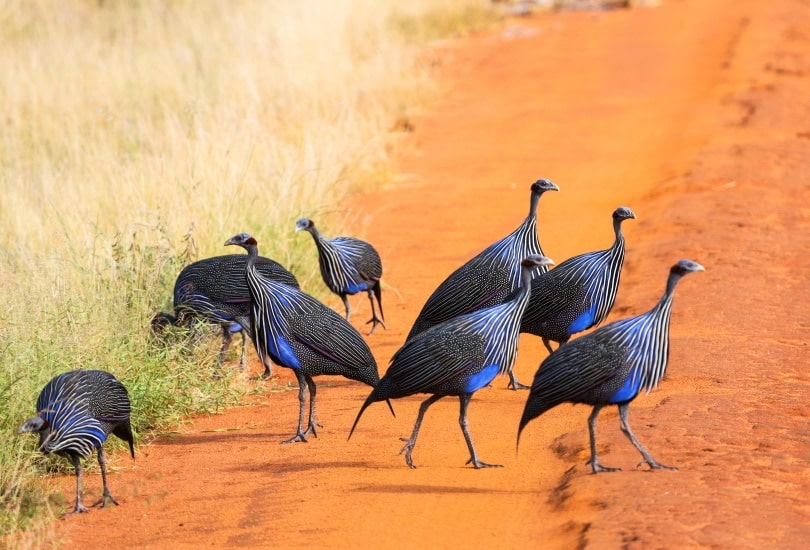With interest in sustainable living and backyard poultry-keeping continuing to rise, potential future homesteaders are interested in learning all they can about the types of animals they might one day care for. Not all species are ideal for small-scale farming and it’s important to learn which ones are suitable before investing time and money. In this article, we’ll tell you about the vulturine guinea fowl, a truly unusual bird that just might fit right into your small farming plans!

Quick Facts About Vulturine Guinea Fowls
| Breed Name: | Vulturine guinea fowl |
| Place of Origin: | Africa |
| Uses: | Meat, eggs, pest control |
| Rooster (Male) Size: | 20-24 inches long |
| Hen (Female) Size: | 20-24 inches long |
| Color: | Blue, black, white |
| Lifespan: | 15 years |
| Climate Tolerance: | Heat tolerant, don’t tolerate below-freezing temperatures |
| Care Level: | Moderate |
| Production: | 40 eggs/year |
Vulturine Guinea Fowl Origins
Vulturine guinea fowl are native to Eastern Africa. They are primarily found in the countries of Kenya, Somalia, Ethiopia, and Tanzania. Their natural habitat is dry, desert areas with grass and a few tall trees to roost in at night.
It is believed that guinea fowl, including the vulturine species, were brought to Europe by the Romans hundreds of years ago. They migrated to America and the Western hemisphere alongside early explorers and settlers.

Vulturine Guinea Fowl Characteristics
Vulturine guinea fowl are the largest of the six known guinea fowl species. In the wild, vulturine guinea fowl form complex, multi-level social groups of a type more often seen among primates. These groups can make up 20-50 birds in total.
Vulturine guinea fowl spend most of their time foraging and living on the ground, rarely flying except up into trees to roost at night. They are known to become aggressive towards each other, with roosters especially prone to bully hens.
In captivity, vulturine guinea fowl need plenty of space, especially if males and females are kept together. They tend to do quite well in captivity although they are not as commonly seen as other species, like the helmeted guinea fowl.
Vulturine guinea fowl are typically monogamous and mate for life. Hens usually lay 4-8 eggs at a time. In captivity, they may produce several clutches per year if the eggs are removed once laid. Eggs hatch after 24 days and both males and females care for the babies.
These birds usually eat insects, worms, and plant materials. Captive birds can forage for their food or eat commercial poultry food supplemented with greens.

Vulturine Guinea Fowl Uses
Vulturine guinea fowl serve a variety of purposes. Some owners keep them as show birds or for ornamental reasons. They can also be raised for meat to eat and eggs to either eat or to hatch for sale.
All guinea fowl, including vulturine, are fantastic at controlling annoying and dangerous pests like ticks. They will also kill snakes and help scare rodents away. Vulturine guinea fowl are also excellent watch birds, sounding the alarm if predators or anything unusual happens in their area.
Vulturine Guinea Fowl Appearance & Varieties
Vulturine guinea fowl get their name from their unusual, bare-skinned heads and necks, which resemble those of vultures. These heads are bluish-gray with a single band of brown feathers just behind the eyes.
Blue feathers line their backs and breasts, overlaid with white stripes and they sport a single black patch in the middle of their chests. The wings and rear of the vulturine guinea fowl are black, spotted, and striped with white.
Male and female vulturine guinea fowl are very similar in size and appearance. Females have smaller spurs than males and males tend to hold their heads higher.

Vulturine Guinea Fowl Population
Vulturine guinea fowl are considered a species of least concern, with about 10,000 wild birds existing in a stable population. The birds are found in zoos and aviaries around the world.
Guinea fowl are bred and raised in many countries including the United Kingdom, the United States, and Australia. Vulturine guinea fowl are not as commonly seen as other species, especially in the United States.
As native desert birds, vulturine guineas can tolerate hot temperatures quite well. However, they need a heated shelter to protect them when temperatures drop below freezing. This allows them to be kept in many different climates worldwide.
Are Vulturine Guinea Fowl Good for Small-Scale Farming?
Vulturine guinea fowl may work well for small-scale farmers depending on how much space is available. Because guinea fowl are social, keeping at least a pair, but preferably a small flock is necessary.
Farmers in cold climates need to provide shelter and heat for their guineas during the winter. Otherwise, the birds are fairly easy to care for, especially if they can forage for a good part of the year.
Vulturine guinea fowl can provide multiple possible income sources for small farmers, from meat and egg production, the sale of chicks, or even the sale of their beautiful feathers.


Conclusion
Vulturine guinea fowl can be a versatile addition to a farm or aviary. And they will certainly earn their keep by controlling the local insect populations. Just be sure you have the space and proper setup to keep these birds before you commit to bringing home a pair, or more! Keeping poultry such as guinea fowl can be both rewarding and profitable if done correctly.
See also:
Featured Image Credit: ChandelleB, Shutterstock
